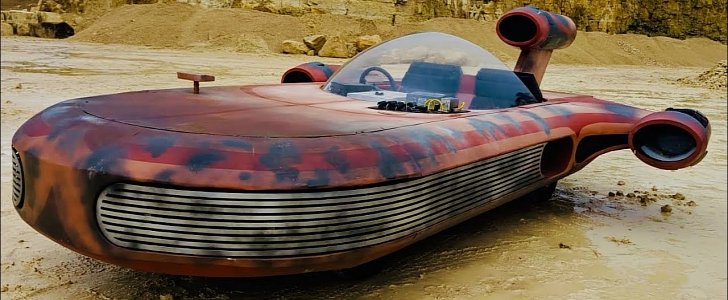Star Wars is a big cinematic universe filled with many alien species, armies of robots and ships as big as planets. However, many argue that the original movies are great because they've got the gritty qualities of a Western. So Luke's Landspeeder is like a wagon, smuggling some tin cans past a couple of stupid soldiers.
The Landspeeder isn't exactly the most epic sci-fi vehicle of all time, and it's difficult to explain its popularity. But it's kind of obtainable, like a wheeled version of the Stormtrooper costume. Did we say wheeled?
Yes, because many people have tried to recreate George Lucas' epic 1977 movie prop. The latest to successfully do so is Colin Furze, a YouTube inventor, car enthusiast and one of the few people who can pull off a tie and short-sleeve shirt.
He was commissioned by eBay to fabricate various Star Wars craft using parts he can find on their website. He starts out with a golf cart chassis and decides on a more powerful 13kW motor. A lot of custom fabrication is necessary to ensure the exterior and even the cockpit are accurate.
And because the Landspeeder has external propulsion pods, some small jet engines get fitted too. These are the kind you'd find on hardcore RC planes and cost a pretty penny. He even managed to copy the idea of putting mirrors underneath, which George used to make it seem like it was actually flying.
We'll end this story with a couple of Landspeeder facts for you Star Wars fans to scrutinize and say we got wrong. Luke's iconic beat-up vehicle cost 10,500 imperial credits new, but only about 2,500 when used, which is equivalent to a couple of blasters. It was 3.4 meters or 11 feet long, so about the size of a Fiat 500. Its top speed was 250 km/h (155 mph), the same as nearly all German cars these days.
Yes, because many people have tried to recreate George Lucas' epic 1977 movie prop. The latest to successfully do so is Colin Furze, a YouTube inventor, car enthusiast and one of the few people who can pull off a tie and short-sleeve shirt.
He was commissioned by eBay to fabricate various Star Wars craft using parts he can find on their website. He starts out with a golf cart chassis and decides on a more powerful 13kW motor. A lot of custom fabrication is necessary to ensure the exterior and even the cockpit are accurate.
And because the Landspeeder has external propulsion pods, some small jet engines get fitted too. These are the kind you'd find on hardcore RC planes and cost a pretty penny. He even managed to copy the idea of putting mirrors underneath, which George used to make it seem like it was actually flying.
We'll end this story with a couple of Landspeeder facts for you Star Wars fans to scrutinize and say we got wrong. Luke's iconic beat-up vehicle cost 10,500 imperial credits new, but only about 2,500 when used, which is equivalent to a couple of blasters. It was 3.4 meters or 11 feet long, so about the size of a Fiat 500. Its top speed was 250 km/h (155 mph), the same as nearly all German cars these days.






